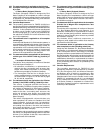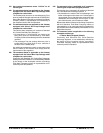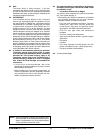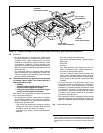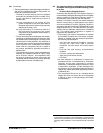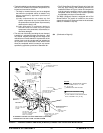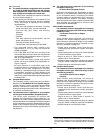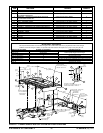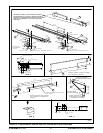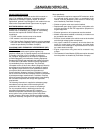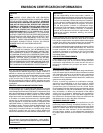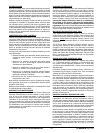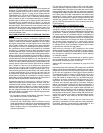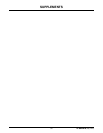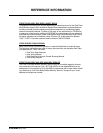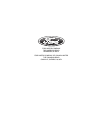
E-SERIES (May, 2004)50
E-SERIES (May, 2004) 51
EMISSION CERTIFICATION INFORMATION
EXTERIOR NOISE
New vehicles which have a gross vehicle weight rating in excess
of 4536 kg [10,000 lb], include a partially or wholly enclosed
operator’s compartment, and are manufactured for use in the
United States, must comply with U.S. Environmental Protection
Agency’s exterior noise emission regulations for medium and
heavy trucks (40 CFR Part 205, Subpart B) which establish a
noise emission limit of 80 dB (A).
However, the Basic (Stripped) Chassis as built by Ford is too
incomplete to constitute a regulated vehicle and Ford does
not represent that it complies with those regulations. With
respect to the Basic (Stripped) Chassis, it is the responsibility
of the subsequent stage manufacturer of that vehicle at the
time it rst conforms to the regulatory denition of “vehicle” to
comply with the requirements imposed upon manufacturers
by these regulations.
TAMPERING WITH NOISE CONTROLS
Federal law prohibits the removal or rendering inoperative by
any person, other than for purposes of maintenance, repair, or
replacement, of any device or element of design incorporated
into such vehicle for the purpose of noise control prior to its
sale or delivery to the ultimate purchaser or while it is in use.
Federal Law also prohibits the use of such vehicle after such
device or element of design has been removed or rendered
inoperative by any person.
Among those acts presumed to constitute tampering are the
acts listed below:
• Removal of fender apron absorbers, fender apron barriers,
underbody noise shields, or acoustical absorptive
material.
• Removal of or rendering inoperative the engine speed
governor so as to allow engine speed to exceed
manufacturer’s specications.
• Removal or modication of air duct, air intake choke or
silencer, air cleaner, or air cleaner element.
• Removal of, or rendering inoperative, exhaust system
components including the catalyst inlet pipe, mufer,
outlet pipe, resonator, or diffuser.
• Removal of the fan shroud. Removal of or rendering
inoperative the fan clutch.
New vehicles manufactured for sale in Canada must comply
with applicable provisions of Canada Motor Vehicle Safety
Standard 1106, Noise.
Additional noise emissions information is contained in the Ford
Truck Body Builders Layout Book.
WARRANTY AND MAINTENANCE
A copy of the appropriate Ford Truck Owners Guide and
Warranty Facts Booklet must be installed in every vehicle
prior to sale to the ultimate purchaser in order to provide
emission systems warranty information and maintenance
schedules. It also provides, where required by EPA noise
control regulations for vehicles having GVWR over 4536 kg
[10,000 lb], noise emissions warranty information, instructions
for maintenance, use, and repair of vehicle noise emission
control systems, a maintenance record format, and list of
prohibited tampering acts.
EVAPORATIVE EMISSIONS
All 2005 Federal light and heavy duty trucks and all California
vehicles with gasoline engines are required to comply
with evaporative emissions requirements established by
the Environmental Protection Agency or the California Air
Resources Board. Production fuel systems supplied on
incomplete 2005 model year trucks manufactured by Ford
Motor Company comply with these requirements. If the
subsequent stage manufacturer adds to or modies the
fuel system in any manner, it becomes the responsibility
of the modier to assure compliance with the applicable
regulations. Refer to the Design Recommendation section of
the Ford Truck Body Builders Layout Book, for additional Fuel
System Evaporative Emissions information.
MALFUNCTION INDICATOR LIGHT (MIL)
The “Malfunction Indicator Light” is used to indicate
malfunctions of the Electronic Engine Control System and
certain emissions-related components. For all incomplete
vehicles, except Basic (Stripped) Chassis (which is not
equipped with an instrument panel), it is Ford installed and
operational.
The E-Series Basic (Stripped) Chassis vehicles, has the
warning light installed in the instrument cluster, which is
shipped in the dunnage box. If an alternate instrument
cluster is utilized, the nal stage manufacturer must install an
operational light in the instrument cluster. This light must glow
amber and display the message “Malfunction Indicator Light
(MIL)”. It should be recognized that this light is a requirement
of emission certication.
OZONE DEPLETING SUBSTANCE (ODS)
The Clean Air Act of 1990, Section 611 requires any product
(i.e., completed vehicle) containing or manufactured with
any Class I Ozone Depleting Substance on, or after May
15,1993 must be identied with a “clearly and conspicuously
attached label.”
Ford Motor Company has eliminated Class I ODS from its
manufacturing processes. All 2005 Ford Truck incomplete
vehicles will not have Class I ODS content.
Manufacturers, including subsequent stage manufacturers,
are required to label their products if the product, including
any component (whether manufactured by that manufacturer
or not), contains a Class I ODS or if the manufacturer used
a Class I ODS in the manufacturing of the product. In the
case where Ford Motor Company provides a label saying the
incomplete vehicle contains a Class I ODS that information
must be placed on the product warning label. (See EPA
regulation on wording, placement, size, and combining labels.)
In Canada consult the appropriate Provincial or Territorial
Ministry of Environment.
EMISSION CONTROL INFORMATION LABEL
To meet United States Environmental Protection Agency
regulations, the Important Vehicle Information (tune-up
and fuel tank capacity) labels must be afxed in the engine
compartment in a location that is readily visible after installation
and in such a manner that it cannot be removed without
destroying or defacing the label. The label shall not be afxed
to any equipment that is easily detached from the vehicle.
When emission control labels are supplied but not attached
to the vehicle (i.e., tune-up label or fuel tank label), they must
be permanently mounted in a readily visible location to meet
the preceding requirements. In addition, whether the label
is already afxed or to be afxed, no components shall be
installed which visibly obscure the label in any way that
fails to satisfy the visibility requirements described in the
California Emission Control Label Specications. For Canadian
requirements consult Section 1100 8 (1) (d) (i), (ii), & (iii),
as applicable.



